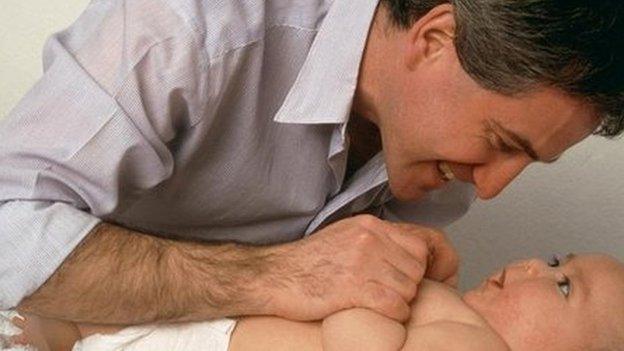Additional Paternity Leave: Low take-up among new fathers
- Published

The existing system of additional paternity leave is to be overhauled next year
Fewer than one in 50 new fathers are using their right to extra paid time off if their partner goes back to work after having a baby, figures suggest.
Additional Paternity Leave was introduced by the coalition government in 2011, and has a current statutory rate of pay of £138.18 per week.
The idea was to allow fathers to spend time with their children beyond the statutory fortnight's paternity leave.
But one MP has warned of "cultural barriers" stopping men from doing so.
Under the scheme, employees are able take up to 26 weeks' leave to care for their child once the mother has returned to work from statutory maternity or adoption leave, or ended her entitlement.
Official figures obtained by shadow childcare minister Lucy Powell show take-up has been minuscule, with just 1.4% of new fathers taking it in 2012-13.
In 2011-12, the first year the scheme was in operation, just 0.8% of eligible dads took advantage of it.
The figures relate to the statutory payments paid by employers to their employees when the employer has claimed the money back from the government.
Some employers may not claim these payments back, especially if they are paying occupational paternity pay above the legal minimum. And some new fathers may pack in work altogether.
'Reluctant'
Lucy Powell said the scale of the challenge, in terms of balancing responsibilities for looking after a new baby, was brought home to her when she was off work to have a baby herself.
"I came back from maternity leave after just four months, so in theory my husband could have had several months off on Additional Paternity Leave," she said.
"I suggested that to him that he do that and he said: 'How do you think that's going to go down at work?'

Some fathers say they cannot afford to take time off work
"Dads feel that in the workplace that it's not really accepted that they might take time off for caring responsibilities, so they are much more reluctant to ask in the first place."
The MP, who had her second child seven months after she was elected to Parliament in 2012, also highlighted figures showing fathers are nearly twice as likely as mothers to have requests for flexible working turned down.
In 2012, 18% of men who requested flexible arrangements were refused, compared with 10% of women.
"Often when men do ask, they are not met with the same sympathy that maybe a mum is," she added.
"So I think there are some cultural barriers for dads themselves and in the workplace and there are some issues too around status and pay as well."
'Not an option'
So what's the view amongst new dads?
Chris Saunders, whose son William is four months old, told me that Additional Paternity Leave was not close to being an option for him as he couldn't afford even the two weeks of conventional paternity leave.
"It doesn't surprise me whatsoever the fact that dads are having to make this decision and so obviously therefore sacrifice time with their new child," he said.
"In my case, I could have the first week paid as my normal salary but the second week it would go down to the normal statutory amount and so I had a bit of a tussle in terms of deciding whether I could just afford to take the first week only or the second week as well and in my case I couldn't afford to take the second week."
The existing system will be replaced next April by what will be called Shared Parental Leave.
Business Minister Jenny Willott said that under the new scheme, eligible working parents would be able to decide how to share up to 50 weeks of leave, including being off at the same time or regularly swapping.
But two big issues are likely to remain: a financial one, for fathers often earning more, and a cultural one - the question of where society, employers and men perceive they belong and should be.
- Published16 June 2013

- Published3 April 2011